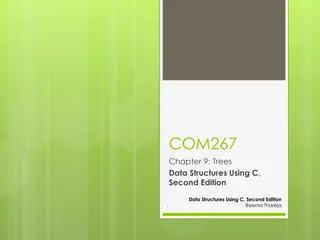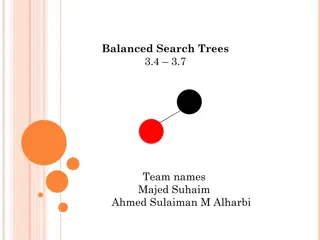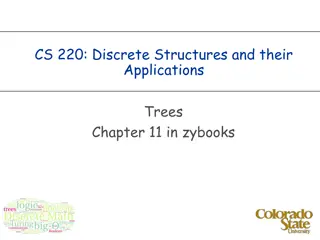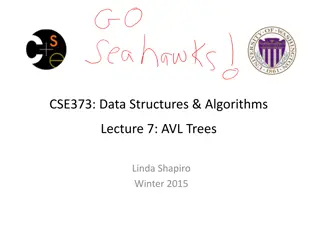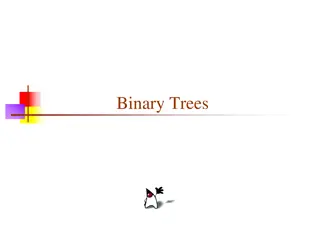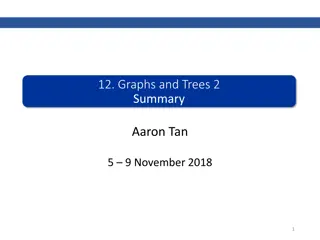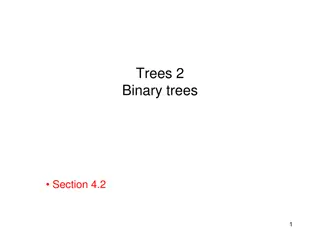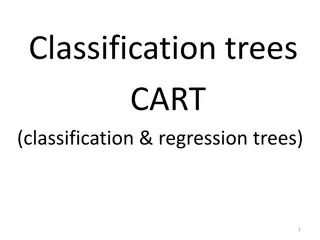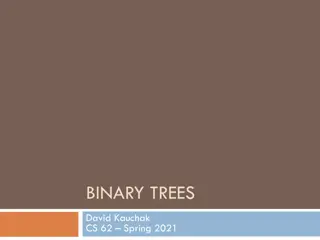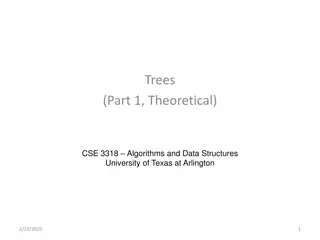
Balanced Binary Search Trees: Importance and Tree Rotations
Learn about the significance of balanced binary search trees (BBSTs) in optimizing search operations, the benefits of maintaining balance in a binary search tree, and how tree rotations play a crucial role in keeping the tree structure efficient and manageable.
Download Presentation

Please find below an Image/Link to download the presentation.
The content on the website is provided AS IS for your information and personal use only. It may not be sold, licensed, or shared on other websites without obtaining consent from the author. If you encounter any issues during the download, it is possible that the publisher has removed the file from their server.
You are allowed to download the files provided on this website for personal or commercial use, subject to the condition that they are used lawfully. All files are the property of their respective owners.
The content on the website is provided AS IS for your information and personal use only. It may not be sold, licensed, or shared on other websites without obtaining consent from the author.
E N D
Presentation Transcript
Balanced Binary Search Trees Ralph McDougall 9 February 2019
What is a BBST? In graph theory, a tree is a connected, undirected graph that does not contain any cycles A binary tree is a tree with one root node and where each node has at most two child nodes A binary search tree is a binary tree where each node is assigned some value and the property holds that for each node V, all nodes in the left subtree of V have a value less than that of V and all nodes in the right subtree of V have a value greater than that of V A balanced binary search tree is a binary search tree where all leaf nodes are as close as possible to the root
Why is a binary search tree useful? If you want to query whether a given value is in the tree, you can easily find where it would be if it were in the tree If the value A is less than the value of some node V, then you know that A must lie in the left subtree of V and vice versa This makes querying whether or not a value is in a dataset significantly faster than naively checking every value in the dataset Since one would expect the maximum height of the tree to be logN where N is the number of nodes present, BSTs allow for O(logN) queries
Why is a balanced binary search tree useful? Optimal BSTs are efficient because of the property that their height is logN However, it is not guaranteed that the height is always logN. If new values are inserted into the tree, one would add them as children of some leaf nodes This can lead to the height of the tree becoming very large and thus reducing the runtime to O(N) A balanced binary search tree introduces extra conditions that must be satisfied at all times when adding values to ensure that the height stays as small as possible
Tree rotations In order to restructure the tree, BBSTs use tree rotations
Tree Rotations (continued) Tree rotations help to shorten the maximum distance from the root to a leaf node Different BBSTs use different heuristics to determine where tree rotations should take place
Types of BBSTs AVL tree Splay tree Red-Black tree
AVL Tree An AVL Tree maintains the property that the difference between a node s left subtree height and right subtree height is at most 1 This means that the AVL tree always has as small of a height as possible Since all queries are worst case O(h) where h is the height of the tree, AVL trees allow for guaranteed O(logN) queries
AVL Tree (continued) AVL Insertions: oInsert a node like you would for a normal BST oWalk from the leaf node to the root oSuppose the nodes visited are V1, V2, V3, , Vkin that order oIf Vidoes not satisfy the AVL property anymore, perform some tree rotations with Vi, Vi - 1and Vi - 2 oThere are 4 cases to consider that affect what tree rotations should be performed (left-left, left-right, right-left, right-right)
AVL Tree (continued some more) Deletion: If you want to remove a node from the tree, perform a standard BST deletion Walk up from where the deleted node was to the root and perform rebalancing in the same manner as was done for insertion
AVL Tree Performance Queries are guaranteed to be O(logN) Insertions are guaranteed to be O(logN) Deletions are guaranteed to be O(logN) There can be quite a large constant overhead as a lot of rotations may need to be performed during insertion and deletion An AVL Tree is thus not the ideal choice if there are a lot more insertions and deletions than queries
Splay Tree A splay tree utilises the 80-20 rule 80% of the queries are to 20% of the elements in a set in a lot of cases Thus, splay trees aim to keep the most recently queried values close to the root
Splay Trees 2: Electric Boogaloo Querying a splay tree is initially identical to querying a normal BST Once the query is completed, tree rotations are performed repeatedly until the last node visited is the new root node
Splay Tree review Query is O(logN) (albeit with a fairly large constant) Insertion and deletion are O(logN) too Splay trees are very useful because they are faster than Red-Black trees and AVL Trees in most modern situations Splay trees are used in the gcc compiler, the implementation of the Unix malloc and for Linux loadable modules
Red-Black Tree Red-Black Tree property: Every node is either red or black The root of the tree is always black If a node is red, it s children must be black Every path from a node to all of its descendant leaf nodes has the same number of black nodes
Red-Black Tree: The Empire Strikes Back For insertion, Red-Black Trees use tree rotations and recolourings When a node V is added to the tree (standard BST insertion), mark it as red If V s parent and uncle are red, make them both black and make V s grandparent red. Repeat this from V s grandparent. If V s parent is red and the uncle is black, there are 4 cases of rotations with V, the parent and the grandparent. Each case has a specific tree rotation and recolouring that needs to be performed. These aren t too difficult to figure out.
Red-Black Tree review All updates and queries are O(logN) Red-Black Trees utilise fewer tree rotations than other BBSTs, making the faster on average for lots of insertions Red-Black Trees should be used when there is a high ratio of insertions to queries
The problem with BBSTs All insertions and queries can be performed in O(logN) with all of the trees that have been covered Which tree you want to use depends on the constraints of the scenario A problem arises: the people that create test data often create pathological test cases that are designed to break commonly used data structures Test-case authors can predict how these trees will look, so they know what cases test them to their limits
The Solution How can the test-case authors predict how your tree will look if your program doesn t even know how the tree will look? Random numbers come to the rescue!
Treap A Treap is the amalgamation of a tree and a heap (By this point in the lecture, you should hopefully know what a tree is) A heap is a data structure with the property that all of a node s children have a value less than it (or larger than it for a min-heap) Queries are performed identically to any BST
You can never have enough Treaps Insertion: Each node that gets inserted is assigned a random priority The node gets inserted in the tree according to the heap property on the priorities The value of the node is used to decide whether it should be inserted into the left or the right subtree Assuming the priorities assigned are true random numbers, the treap will remain reasonably well balanced at all times
Treap Review All queries and insertions are O(logN) No matter what test data is given, the treap should always be balanced allowing for very fast queries It is a good idea to seed your random number generator since your submissions should always run identically if the same input data is given
TL;DR Treaps are cool


